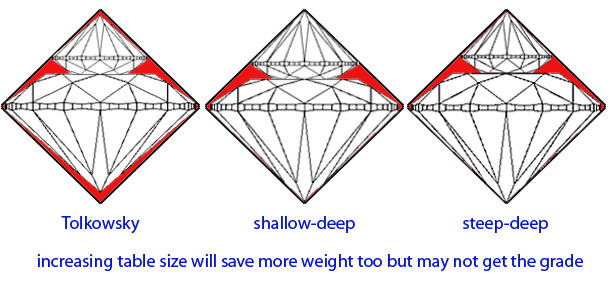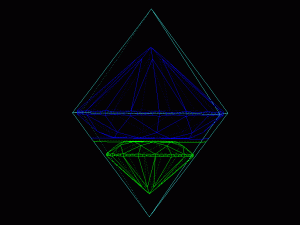Thanks Ellen, Aljdewey and Lop. Working Hard - wouldn't mind going to look at lots of diamonds but not able to at the moment unfortunately. I think a part of the reason I said I didn't love the stone was because I was not used to the smaller table size compared to 57.5 or larger tables and as the table is smaller the pavillion by comparison looks smaller through the table and seemed to give me the illusion of being deeper and what I was callilng cone like whereas a large table you see more of the pavillion on show through the table area, I think this is what I was seeing as something I did not love and attributing it wrongly in my mind to the 41 degree pavillion angle which I already had doubts about from information I had read on the forum (not from Whiteflash).
Now I think I know it is the table it doesn't bother me the same so it was a mind clean thing. I have looked at Pricescopers diamonds and lots of them bought from Whiteflash and I see this same what I was describing as cone look but now I am used to it I don't see it as that anymore but just as a smaller table. So it is my perception of how diamonds looked with larger tables that was confusing me, either that or I am thinking that maybe larger diamonds show a larger crown area around the table. I knew before I got the diamond it would probably have a smaller table but the 41 pavillion angle took over and put that out of my mind.
I did though after Brian the Cutter posted ask Jonathan a question by email and he knew I was hesitating on the diamond and I do put faith in what Brian writes as I do the other experts/Scientists here. I read that he had written that I was weighing heavily Brian's words right after that email so that was just Jonathan reporting it as it was.
As I have mentioned before though the images Brian posted with the rough diamond showing the Tolkowsky diamond is not cut to save rough, what do people think about that, I have seen images similar to that before on the internet, and I always thought that was educating consumers about how a well cut diamond is judged because it was cut without trying to save weight? I know cutters do cut to save weight as I have read that for years too. So are the scientists not in agreement with that diagrams?
Now I think I know it is the table it doesn't bother me the same so it was a mind clean thing. I have looked at Pricescopers diamonds and lots of them bought from Whiteflash and I see this same what I was describing as cone look but now I am used to it I don't see it as that anymore but just as a smaller table. So it is my perception of how diamonds looked with larger tables that was confusing me, either that or I am thinking that maybe larger diamonds show a larger crown area around the table. I knew before I got the diamond it would probably have a smaller table but the 41 pavillion angle took over and put that out of my mind.
I did though after Brian the Cutter posted ask Jonathan a question by email and he knew I was hesitating on the diamond and I do put faith in what Brian writes as I do the other experts/Scientists here. I read that he had written that I was weighing heavily Brian's words right after that email so that was just Jonathan reporting it as it was.
As I have mentioned before though the images Brian posted with the rough diamond showing the Tolkowsky diamond is not cut to save rough, what do people think about that, I have seen images similar to that before on the internet, and I always thought that was educating consumers about how a well cut diamond is judged because it was cut without trying to save weight? I know cutters do cut to save weight as I have read that for years too. So are the scientists not in agreement with that diagrams?





300x240.png)